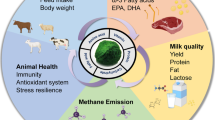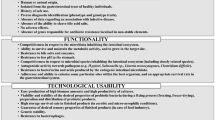Abstract
Ruminal fermentation of feed leads to methane production and wastes feed energy. Appropriate feed additives have shown to reduce ruminal methane production. Accordingly, it is important to identify compounds as feed additives to alter ruminal fermentation patterns to improve feed efficiency as well as reduce methane production. This experiment aimed to investigate the effect of inulin additive (as a prebiotic compound) on ruminal fermentation, feed digestibility, and methane production by in vitro techniques. Experimental treatments included control treatment (basal diet), 2% (w/w) inulin (basal diet with 2% inulin), and 4% (w/w) inulin (basal diet with 4% inulin). Gas production at 2, 4, 6, 12, 24, 48, 72, and 96 h of incubation as well as dry matter (DM) and organic matter digestibility (OMD) was determined. Also, some rumen fermentation parameters including pH, ammonia–nitrogen, volatile fatty acids, and methane production were determined. Per our findings, the addition of inulin increased gas production except for the first 2 h of incubation (p < 0.05). The addition of inulin changed the profile of ruminal volatile fatty acids (p < 0.05) so that the addition of inulin increased the concentration of propionic acid (p < 0.05). The addition of inulin also reduced lactic acid concentration (p < 0.05). Rumen ammonia–nitrogen was reduced by the addition of inulin (p < 0.05), which could indicate an improvement in rumen nitrogen metabolism. Addition of inulin reduced methane production from feed fermentation by rumen microbiota (p < 0.05). Dry matter and organic matter digestibility increased with the addition of inulin (p < 0.05). According to the results, the use of inulin (as a prebiotic of plant origin) not only does not disrupt ruminal fermentation but also improves the fermentation process, increases feed digestibility, and most importantly reduces methane excretion, which can increase production efficiency.
Graphical abstract




Similar content being viewed by others
Data availability
The datasets generated during and/or analyzed during the current study are available from Dr. Hamid Paya on reasonable request.
References
Esmailidoabi E, Bayatkouhsar J, Rezaii F, Mostafalou Y, Gharebash AM, (2020) Gas production and in vitro digestibility of various sources of non-fiber carbohydrates and rumen degradable protein. Iran J Animal Sci Res 11:413–424
Palangi V, Macit M (2021) Indictable mitigation of methane emission using some organic acids as additives towards a cleaner ecosystem. Waste Biomass Valori 12:4825–4834. https://doi.org/10.1007/s12649-021-01347-8
Tewari D, Chaturvedi VB, Chandra Chaudhary LC, Verma AK, Chaudhary SK (2021) Dietary supplementation of rice bran crude lecithin affect feed digestion, blood and rumen profile in crossbred calves. Research Square 1–21. https://doi.org/10.21203/rs.3.rs-898144/v1
Giller K, Bossut L, Eggerschwiler L, Terranova M (2021) In vitro ruminal fermentation, methane production and nutrient degradability as affected by fruit and vegetable pomaces in differing concentrations. J Anim Physiol Anim Nut 00:1–11. https://doi.org/10.1111/jpn.13656
Granja-Salcedo YT, Fernandes RM, Araujo RC, Kishi LT, Berchielli TT, Resende FD, Berndt A, Siqueira GR (2019) Long-term encapsulated nitrate supplementation modulates rumen microbial diversity and rumen fermentation to reduce methane emission in grazing steers. Front Microbiol 10:614. https://doi.org/10.3389/fmicb.2019.00614
Yang K, Wei C, Zhao GY, Xu ZW, Lin SX (2017) Effects of dietary supplementing tannic acid in the ration of beef cattle on rumen fermentation, methane emission, microbial flora and nutrient digestibility. J Anim Physiol Anim Nutr 101:302–310. https://doi.org/10.1111/jpn.12531
Tian K, Liu J, Sun Y, Wu Y, Chen J, Zhang R, He T, Dong G (2019) Effects of dietary supplementation of inulin on rumen fermentation and bacterial microbiota, inflammatory response and growth performance in finishing beef steers fed high or low-concentrate diet. Anim Feed Sci Technol 258:114299. https://doi.org/10.1016/j.anifeedsci.2019.114299
Wang Y, Nan X, Zhao Y, Jiang L, Wang H, Hua D, Zhang F, Wang Y, Liu J, Yao J, Xiong B (2021) Dietary supplementation with inulin improves lactation performance and serum lipids by regulating the rumen microbiome and metabolome in dairy cows. Anim Nut 7:1189–1204. https://doi.org/10.1016/j.aninu.2021.09.007
Mudannayake DC, Wimalasiri KM, Silva KF, Ajlouni S (2015) Comparison of properties of new sources of partially purified inulin to those of commercially pure chicory inulin. J Food Sci 80(5):C950–C960. https://doi.org/10.1111/1750-3841.12857
Jonova S, Ilgaza A, Zolovs M (2021) The impact of inulin and a novel synbiotic (yeast Saccharomyces cerevisiae strain 1026 and inulin) on the development and functional state of the gastrointestinal canal of calves. Veterinary Medicine International 2021: Article ID 8848441. https://doi.org/10.1155/2021/8848441
Zhao Y, Wang Y, Nan X, Jiang L, Wang Y, Liu J, Yao J, Rahman MT, Xiong B (2022) Responses of lactation, rumen fermentation and blood biochemical parameters with increasing dietary inulin supplementation in mid-lactation dairy cows. Agriculture 12:521. https://doi.org/10.3390/agriculture12040521
Umurcalilar HD, Glen N, Hayirli A, Alata MS (2010) Potential role of inulin in rumen fermentation. Revue Méd Vét 161(1):3–9
Zhao XH, Gong JM, Zhou S, Liu CJ, Qu MR (2014) The effect of starch, inulin, and degradable protein on ruminal fermentation and microbial growth in rumen simulation technique. Italian J Anim Sci 13:189–190. https://doi.org/10.4081/ijas.2014.3121
AOAC (2005) Official methods of analysis of AOAC International. AOAC international. Maryland, USA.
Van Soest PJ, Robertson JB, Lewis BA (1991) Methods for dietary fiber, neutral detergent fiber and non-starch polysaccharides in ration to animal nutrition. J Dairy Sci 74(10):3583–3597. https://doi.org/10.3168/jds.S0022-0302(91)78551-2
Fedorah PM, Hrudey SE (1983) A simple apparatus for measuring gas production by methanogenic culture in serum bottles. Environ Technol Let 4:425–432. https://doi.org/10.1080/09593338309384228
NRC (2007) Nutrient requirements of small ruminants: sheep, goats, cervids, and New World camelids. National Academy Press, Wash-ington, DC
McDougall EI (1948) Studies on ruminant saliva. 1. The composition and output of sheep’s saliva. Biochem J 43(1): 99–109. https://doi.org/10.1042/bj0430099
Menke KH, Raab L, Salewski A, Steingass H, Fritz D, Schneider W (1979) The estimation of the digestibility and metabolizable energy content of ruminant feedingstuffs from the gas production when they are incubated with rumen liquor in vitro. J Agric Sci 93:217–222. https://doi.org/10.1017/S0021859600086305
Menke KH, Steingass H (1988) Estimation of the energetic feed value obtained from chemical analysis and in vitro gas production using rumen fluid. Anim Res Dev 28(1):7–55
Getachew G, Makkar HPS, Becker K (2002) Tropical browses: contents of phenolic compounds, in vitro gas production and stoichiometric relationship between short chain fatty acid and in vitro gas production. J Agric Sci 139(3):341–352. https://doi.org/10.1017/S0021859602002393
Holden LA (1999) Comparison of methods of in vitro dry matter digestibility for ten feeds. J Dairy Sci 82(8):1791–1794. https://doi.org/10.3168/jds.S0022-0302(99)75409-3
Adejoro FA, Hassen A, Akanmu AM, Morgavi DP (2020) Replacing urea with nitrate as a non-protein nitrogen source increases lambs’ growth and reduces methane production, whereas acacia tannin has no effect. Anim Feed Sci Technol 259:114360. https://doi.org/10.1016/j.anifeedsci.2019.114360
Broderick GA, Kang JH (1980) Automated simultaneous determination of ammonia and total amino acids in ruminal fluid and in vitro media. J Dairy Sci 63(1):64–75. https://doi.org/10.3168/jds.S0022-0302(80)82888-8
Paya H, Taghizadeh A, Janmohammadi H, Moghaddam GA, Hossein Khani A, Alijani S (2014) Effects of microwave irradiation on in vitro ruminal fermentation and ruminal and post-ruminal disappearance of safflower seed. J Biodiversity Environ Sci 8:349–356
Moharrery A, Larsen M, Weisbjerg MR (2014) Starch digestion in the rumen, small intestine, and hind gut of dairy cows – a meta-analysis. Anim Feed Sci Technol 192:1–14. https://doi.org/10.1016/j.anifeedsci.2014.03.001
Gumilar DAKW, Rianto E, Arifin M (2017) The concentration of rumen fluid volatile fatty acids and ammonia and rumen microbial protein production in sheep given feed during the day and night time. Earth Environ Sci 119https://doi.org/10.1088/1755-1315/119/1/012045
Bąkowski M, Kiczorowska B (2021) Probiotic microorganisms and herbs in ruminant nutrition as natural modulators of health and Production efficiency – a review. Ann Anim Sci 21:3–28. https://doi.org/10.2478/aoas-2020-0081
Honan M, Feng X, Tricarico JM, Kebreab E (2021) Feed additives as a strategic approach to reduce enteric methane production in cattle: modes of action, effectiveness and safety. Anim Prod Scihttps://doi.org/10.1071/AN20295
Beauchemin KE, Ungerfeld EM, Eckard RJ, Wang M (2020) Review: fifty years of research on rumen methanogenesis: lessons learned and future challenges for mitigation. Animal 14:2–16. https://doi.org/10.1017/S1751731119003100
Kafilzadeh F, Payandeh S, Gómez-Cortés P, Ghadimi D, Schiavone A, Martínez Marín AL (2019) Effects of probiotic supplementation on milk production, blood metabolite profile and enzyme activities of ewes during lactation. Italian J Anim Sci 18:134–139. https://doi.org/10.1080/1828051X.2018.1496040
Funding
This work has been supported by University of Tabriz, International and Academic Cooperation Directorate, in the framework of TabrizU-300 program.
Author information
Authors and Affiliations
Contributions
HP, AT, and IG conceived and designed research. AH, KH, MM, HP, VP and SS conducted experiments. NE contributed new reagents or analytical tools. VP and TA analyzed data. HP wrote the manuscript. All authors read and approved the manuscript.
Corresponding authors
Ethics declarations
Ethics approval
This study was performed in accordance with experimental animal ethics committee of the University of Tabriz (Protocol no. IR.TABRIZU.REC.1400.029).
Consent to participate
Not applicable.
Consent for publication
This study did not involve children or individual details, but 100% data usage.
Conflict of interest
The authors declare no competing interests.
Additional information
Publisher's note
Springer Nature remains neutral with regard to jurisdictional claims in published maps and institutional affiliations.
Novelty
Due to the increase in world population, the use of livestock products is of particular importance. Ruminant breeding greatly contributes to methane emission due to fermentation of feed by ruminal microorganisms. Methane production, on the one hand, intensifies the greenhouse effect and, on the other hand, wastes feed energy and reduces feed efficiency. In this context, researchers have conducted numerous experiments to introduce feed additives to change the rumen fermentation process in the rumen and reducing methane production while increasing feed efficiency. One of the natural additives that can change the feed fermentation pattern in rumen is inulin, which has been studied in this study.
Supplementary Information
Below is the link to the electronic supplementary material.
Rights and permissions
About this article
Cite this article
Paya, H., Giannenas, I., Taghizadeh, A. et al. Impact of inulin supplementation on mitigating ruminal emissions of methane. Biomass Conv. Bioref. 14, 8493–8501 (2024). https://doi.org/10.1007/s13399-022-02882-7
Received:
Revised:
Accepted:
Published:
Issue Date:
DOI: https://doi.org/10.1007/s13399-022-02882-7




